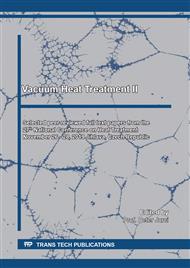[1]
P. Jurči, M. Dománková, L. Čaplovič, J. Ptačinová, J. Sobotová, P. Salabová, O. Prikner, B. Šuštaršič, D. Jenko, Microstructure and hardness of sub-zero treated and no tempered P/M Vanadis 6 ledeburitic tool steel. Vacuum, 2015, 111, p.92 – 101,.
DOI: 10.1016/j.vacuum.2014.10.004
Google Scholar
[2]
P. Jurči, Structural changes in Cr-V ledeburitic steel during austenitizing and quenching. Materials Engineering, Vol. 17, 2010, No. 1.
Google Scholar
[3]
D. Das, A.K. Dutta, K.K. Ray, Sub-zero treatments of AISI D2 steel: Part II. Wear behaviour. Mater. Sci. Engng. 2010, A527, 2194 – 2206,.
DOI: 10.1016/j.msea.2009.10.071
Google Scholar
[4]
P.F. Stratton, Optimising nano-carbide precipitation in tool steels. Mater. Sci. Engng. 2007, A449-451, 809 – 812,.
DOI: 10.1016/j.msea.2006.01.162
Google Scholar
[5]
D. Mohan Lal, S. Renganarayanan, A. Kalanihidi, Cryogenic treatment to augment wear resistance of tool and die steels. Cryogenics 2001, 41, 149 – 155,.
DOI: 10.1016/s0011-2275(01)00065-0
Google Scholar
[6]
K. Amini, A. Akhbarizadeh, S. Javadpour, Investigating the effect of the quench environment on the final microstructure and wear behaviour of 1.2080 tool steel after deep cryogenic heat treatment. Mater. Design 2013, 45, 316 – 322,.
DOI: 10.1016/j.matdes.2012.08.006
Google Scholar
[7]
A. Akhbarizadeh, K. Amini, S. Javadpour, Effects of applying an external magnetic field during the deep cryogenic heat treatment on the corrosion resistance and wear behaviour of 1.2080 tool steel. Mater. Design 2012, 41, 114 – 123,.
DOI: 10.1016/j.matdes.2012.03.045
Google Scholar
[8]
K. Amini, A. Akhbarizadeh, A., Javadpour, S.: Investigating the effect of holding duration on the microstructure of 1.2080 tool steel during the deep cryogenic treatment. Vacuum 2012, 86, 1534 – 1540,.
DOI: 10.1016/j.vacuum.2012.02.013
Google Scholar
[9]
J. Ptačinová, V. Sedlická, M. Hudáková, I. Dlouhý, P. Jurči, Microstructure - Toughness relationships in sub-zero treated and tempered Vanadis 6 steel compared to conventional treatment. Materials science and engineering. Section A. Structural materials. Properties, microstructure and processing. Vol. 702, 15. august (2017), s. 241-258. ISSN 0921-5093,.
DOI: 10.1016/j.msea.2017.07.007
Google Scholar
[10]
J. Sobotová, P. Jurči, I. Dlouhý, The effect of subzero treatment on microstructure, fracture toughness, and wear resistance of Vanadis 6 tool steel, Mater. Sci. Engng., A652 (2016) 192 – 204,.
DOI: 10.1016/j.msea.2015.11.078
Google Scholar
[11]
H. Berns, Restaustenit in ledeburitischen Chromstählen und seine Umwandlung durch Kaltumformen, Tiefkühlen und Anlassen. HTM 1974, 29 (4), 236 – 247.
DOI: 10.1515/htm-1974-290402
Google Scholar
[12]
M. Pellizzari, A. Molinari, Deep Cryogenic Treatment of Cold Work Tool Steel. In: Proc. of the 6th Int. Tooling Conf., Karlstad, Sweden. September 10 – 13, 2002, Eds. J. Bergstrom, G. Fredriksson, M. Johansson, O. Kotik, F. Thuvander. Karlstad University, 547 - 558.
Google Scholar
[13]
P. Jurči, J. Sobotová, P. Salabová, O. Prikner, B. Šuštaršič, D. Jenko, Subzero treatment of P/M Vanadis 6 ledeburitic tool steel. Int. Heat Treatment and Surf. Engng. 2013, 7, 125 – 128,.
DOI: 10.1179/1749514813z.00000000073
Google Scholar
[14]
A.I. Tyshchenko, W. Theisen, A. Oppenkowski, S. Siebert, O.N. Razumov, A.P. Skoblik, V.A. Sirosh, J.N. Petrov, V.G. Gavriljuk, Low-temperature martensitic transformation and deep cryogenic treatment of a tool steel. Mater. Sci. Engng. 2010, A527, 7027 – 7039,.
DOI: 10.1016/j.msea.2010.07.056
Google Scholar
[15]
D.N. Collins, J. Dormer, Deep Cryogenic Treatment of a D2 Cold-Work Tool Steel. Heat Treatment of Metals 1997, 24, 71 - 74.
DOI: 10.1179/174951508x446376
Google Scholar
[16]
V.G. Gavriljuk, W. Theisen, V.A. Sirosh, E.V. Polshin, A. Kortmann, G.S. Mogilny, Yu. N. Petrov, Y.V. Tarusin, Low-temperature martensitic transformation in tool steels in relation to their deep cryogenic treatment. Acta Mater. 2013, 61, 1705 – 1715,.
DOI: 10.1016/j.actamat.2012.11.045
Google Scholar
[17]
D. Das, K.K. Ray, Structure-property correlation of sub-zero treated AISI D2 steel. Mater. Sci. Engng. 2012, A541, 45 – 60,.
DOI: 10.1016/j.msea.2012.01.130
Google Scholar
[18]
W. Reitz, J. Pendray, Cryoprocessing of Materials: A Review of Current Status. Materials and Manufacturing Processes. 2001. vol. 16, p.829 – 840,.
DOI: 10.1081/amp-100108702
Google Scholar
[19]
Z. Zurecki, Cryogenic Quenching of Steel Revisited. In: Proc. 23rd Heat Treating Society Conference. Pittsburgh, PA, USA. 2005. p.106 – 114.
Google Scholar
[20]
P. Stratton, M. Graf, The effect of deep cold induced nano-carbides on the wear of case hardened components. Cryogenics. 2009. vol. 49, p.346 – 349,.
DOI: 10.1016/j.cryogenics.2009.03.007
Google Scholar
[21]
ASTM E975-13: Standard Practice for X-Ray Determination of Retained Austenite in Steel with Near Random Crystallographic Orientation, In: ASTM Book of Standards, vol. 3.01, West Conshohocken, PA, USA, (2004).
DOI: 10.1520/e0975-03r08
Google Scholar
[22]
P. Bílek, J. Sobotová, P. Jurči, Materiali in Tehnologije/Materials and Technology, 44 (2011) 33.
Google Scholar


